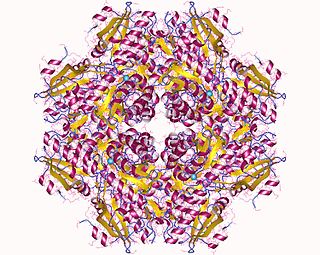| carboxy-cis,cis-muconate cyclase | |||||||||
|---|---|---|---|---|---|---|---|---|---|
| Identifiers | |||||||||
| EC no. | 5.5.1.5 | ||||||||
| CAS no. | 37318-55-1 | ||||||||
| Databases | |||||||||
| IntEnz | IntEnz view | ||||||||
| BRENDA | BRENDA entry | ||||||||
| ExPASy | NiceZyme view | ||||||||
| KEGG | KEGG entry | ||||||||
| MetaCyc | metabolic pathway | ||||||||
| PRIAM | profile | ||||||||
| PDB structures | RCSB PDB PDBe PDBsum | ||||||||
| Gene Ontology | AmiGO / QuickGO | ||||||||
| |||||||||
In enzymology, a carboxy-cis,cis-muconate cyclase (EC 5.5.1.5) is an enzyme that catalyzes the chemical reaction
- 3-carboxy-2,5-dihydro-5-oxofuran-2-acetate 3-carboxy-cis,cis-muconate
Hence, this enzyme has one substrate, 3-carboxy-2,5-dihydro-5-oxofuran-2-acetate, and one product, 3-carboxy-cis,cis-muconate.
This enzyme belongs to the family of isomerases, specifically the class of intramolecular lyases. The systematic name of this enzyme class is 3-carboxy-2,5-dihydro-5-oxofuran-2-acetate lyase (decyclizing). This enzyme is also called 3-carboxymuconate cyclase. This enzyme participates in benzoate degradation via hydroxylation.





